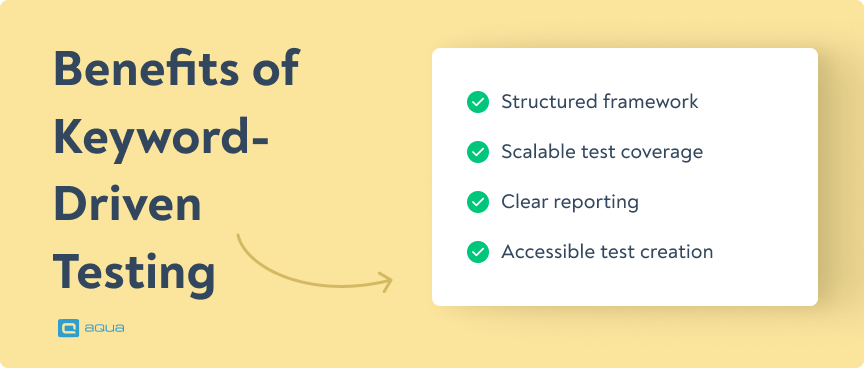Key Takeaways
- Keyword-driven testing separates test design from implementation by using predefined keywords that represent specific actions, allowing for more maintainable test suites.
- Teams using keyword-driven testing report approximately 70% reduction in maintenance efforts when application interfaces change, as only keyword implementations need updating.
- The framework requires significant upfront investment to design the system, create keywords, and implement them before running the first test.
- Robot Framework, Selenium, Ranorex, and TestRigor are popular tools that support keyword-driven testing approaches for different testing needs.
- Non-technical team members can create and understand test cases without coding knowledge, expanding who can contribute to testing across the organization.
Thinking your test scripts are too brittle? Keyword-driven testing might save your team weeks of rework when UI changes occur, but it comes with setup costs. Discover if this approach fits your testing strategy in the full article below 👇
Sounds familiar?
Testing shouldn’t be this painful. If you’re drowning in brittle test scripts or watching your QA team struggle with maintenance nightmares, keyword-driven testing might be your life raft. Let us show you why.
Understanding Keyword Driven Testing
Keyword-driven testing (KDT) is a testing approach that separates what your tests do from how they’re implemented. Instead of writing detailed scripts, you build tests using predefined keywords that represent specific actions like “Click Button,” “Enter Text,” or “Verify Content”, or even something of a higher level-logic, like just “Login”.
Each keyword acts as a building block that performs a specific function. Some keywords handle simple actions like clicking a button, while others manage complex operations like validating an entire checkout process. When combined, these keywords create complete test cases that anyone on the team can understand.
This approach creates a layer of abstraction between test logic and implementation details. When the application changes, you only need to update the keyword implementation, not every test case that uses it.
Curious how well your current setup uses this level of abstraction?
Use the quick evaluator below to see where you stand and how much value you’re getting from keyword-driven testing in practice.
Why Use Keyword Driven Testing?
Several compelling reasons make keyword-driven testing attractive for modern software teams:
Better collaboration between technical and non-technical team members
With KDT, business analysts and subject matter experts can create test cases using simple keywords while developers implement the technical details behind those keywords. This creates a natural partnership where everyone contributes their strengths.
Lower maintenance requirements
When application changes happen, you only need to update the keyword implementation rather than dozens or hundreds of individual test scripts. Research shows that following good KDT design practices can reduce required maintenance changes
by approximately 70%.
Earlier test development
Teams can start writing test cases using keywords before the application is fully built. The technical implementation of those keywords can happen later, allowing testing and development to proceed in parallel.
Efficient knowledge reuse
Once your team builds a library of keywords, creating new test cases becomes much faster.
A study carried out by GitHub shows that about 60% of keywords get reused across test cases, leading to approximately 51.56% savings in test code.
Benefits of Keyword Driven Testing
Keyword-driven testing offers several specific advantages that make it worth considering:
Accessible test creation
Non-programmers can create and understand test cases without coding knowledge. This expands who can contribute to testing and makes test cases more accessible across the organization.
Structured framework
The keyword approach enforces consistency in how tests are designed and implemented. This structure helps teams standardize their testing approach and makes onboarding new testers easier.
Scalable test coverage
As your keyword library grows, creating comprehensive test coverage becomes faster. Teams can quickly assemble test cases from existing keywords to test new features or scenarios.
Clear reporting
Keywords make test results easier to interpret and report. Instead of cryptic code failures, reports show which business-relevant action failed.

Keyword-driven tests or BDD (Behavior-Driven Development) are not only for people without coding knowledge; they also speed up test-related analysis. Unfortunately, most people overlook this.
To achieve all these without skipping a beat and limiting yourself to keyword-driven testing, you need a comprehensive test management system (TMS). And a primary example of such TMS is aqua cloud, an AI-powered test management solution designed to streamline all aspects of your testing with modern approaches, not just keyword-driven testing.
Keyword-driven testing makes test creation accessible, structured, and scalable—aqua cloud takes your testing to the next level. AI-powered assistance lets you create requirements, test cases, and test data 98% faster, even without coding. A centralised repository and structured framework ensure consistency, while seamless automation integrations expand test coverage effortlessly. With 100% traceability and clear reporting, you don’t just run tests—you get actionable insights that drive quality forward. Ready to take your testing above and beyond old-style methods?
Speed up your testing efforts by 100% with an AI-powered TMS
How Keyword Based Testing Works
Keyword-driven testing operates through a straightforward but powerful structure that separates test cases (what to test) from test scripts (how to test them).
The workflow typically follows these steps:
- Define keywords that represent actions in your application
- Create test cases using these keywords in a format like spreadsheets or specialized tools
- Implement the keywords with programming code that executes the actual actions
- Run the tests through a test execution engine that reads the keywords and calls the appropriate code
- Review results that show which keywords passed or failed.
What are the types of keywords used in keyword-driven testing?
Keywords typically fall into two categories:
Low-level keywords perform basic actions like clicking buttons, entering text, or navigating to URLs. These are the building blocks that handle direct interaction with the application.
High-level keywords combine multiple low-level keywords to perform complete business processes like “Log In” or “Complete Purchase.” These make tests more readable and business-focused.
The test execution engine acts as the translator between human-readable keywords and executable code. When you run a test, the engine reads each keyword, identifies the corresponding implementation code, and executes it against your application.
Phases of Keyword Driven Testing
Design Phase
The design phase focuses on planning your keyword framework and identifying which keywords you’ll need. This involves analyzing your application, breaking down common actions, and deciding which keywords to create.
During this phase, you’ll:
- Map out typical user flows through your application
- Identify repeatable actions that make good keyword candidates
- Define naming conventions for your keywords
- Plan your keyword hierarchy (low-level vs. high-level)
- Create documentation standards for keywords
Many teams involve both technical and non-technical stakeholders in this phase to ensure the keywords will be usable by everyone.
Development Phase
In the development phase, programmers implement each keyword with code that interacts with the application. This typically involves:
- Writing functions or methods that execute the action represented by each keyword
- Creating proper error handling and reporting
- Building in appropriate waits and synchronization
- Setting up test data handling
- Developing logging mechanisms
Implementation and Execution Phase
With the keywords defined and implemented, the team can now create and run test cases. This involves:
- Building test cases by combining keywords in the proper sequence
- Adding test data for different scenarios
- Executing tests through the test runner
- Analysing results and refining keywords as needed
- Adding new keywords as requirements evolve
This phase is often iterative, with keywords evolving as your application and testing needs change.
Components of a Keyword Driven Testing Framework
A complete keyword-driven testing framework includes several essential components:
Keyword Library
This is the collection of all your keywords and their implementations. Think of it as a dictionary that defines what each keyword does.
Test Data Repository
Separate from the keywords themselves, this component stores the data used during test execution. Keeping test data separate allows you to run the same test with different data sets.
Object Repository
Especially important for UI testing, this component stores locators and identifiers for UI elements. When the UI changes, you only need to update this repository rather than every keyword that interacts with those elements.
Test Execution Engine
This component reads test cases and calls the appropriate keyword implementations. It handles the flow of execution, reporting, and error management.
Reporting and Logging System
This tracks test execution and results, providing insights into which tests passed or failed and why.
Common Framework Structures
Keyword driven test frameworks typically follow one of several common architectural patterns:
Linear Keyword Framework
This simplest structure arranges keywords in a linear sequence. Each test case is a series of keywords executed in order. While easy to understand, this approach offers limited flexibility.
Modular Keyword Framework
This structure organizes keywords into modules based on application functionality. Keywords for the login might be in one module, while shopping cart keywords are in another. This improves organization and maintenance.
Hybrid Keyword Framework
This combines keyword-driven testing with other approaches like data-driven testing. The framework uses keywords but pulls data from external sources to run the same keywords with different inputs.
Library Architecture Framework
This advanced structure organises keywords into libraries that can be imported as needed. It promotes reusability and prevents keyword duplication across projects.
Comparison: Keyword Driven vs Data Driven Testing
While both approaches aim to make testing more efficient, keyword-driven and data-driven testing serve different primary purposes:
| Aspect | Keyword Driven Testing | Data Driven Testing |
|---|---|---|
| Primary Focus | Actions and operations | Different data inputs |
| Structure | Built around keywords representing user actions | Built around data sets |
| Best For | Standardizing test procedures | Testing with many data variations |
| Technical Barrier | Lower – non-programmers can create tests | Higher – Requires more technical setup |
The good news? You don’t have to choose just one. Many teams implement hybrid frameworks that combine the strengths of both approaches.
Limitations of Keyword Driven Testing
Despite its many benefits, keyword-driven testing isn’t perfect. Being aware of its limitations helps you implement it more effectively:
Initial Setup Time
Creating a keyword framework requires significant upfront investment before you see benefits. You need to design the framework, create keywords, and implement them before running your first test.
"Even if the keyword-driven approach allows you to be quickly productive, you're limited when you have to scale. The control flows (loops, conditions, ...) are not as flexible, rich and intuitive as what you can achieve with a programming language. You also have less possibilities in your design (OOP, ...), fewer choices as the ecosystem of libraries is rather limited. You have to decide when you should write some python code, create some new keywords ..."
Keyword Management Challenges
As your keyword library grows, managing it becomes more complex. Without proper governance, you may end up with duplicate keywords or inconsistent naming.
Technical Debt Risk
If not properly maintained, keyword test frameworks can accumulate technical debt. Research indicates that over 30% of keywords are typically duplicated in projects, creating maintenance headaches.
Learning Curve
While non-technical team members can use keywords, creating an effective keyword framework requires technical expertise and proper design principles.
Syntax Errors
Some keyword frameworks are susceptible to syntax issues that only appear during runtime.
By design a keyword driven framework is less flexible than any libraries directly relying on a modern programming languages: limited control structure, no OOP, FP...
Tools for Keyword Driven Testing
Several powerful tools support keyword driven testing framework:
Selenium
While not inherently keyword-driven, Selenium can be adapted to support KDT. Many teams build keyword frameworks on top of Selenium’s WebDriver API. Keyword-driven frameworks in Selenium have been popular for quite some time, but as testing methods improve, they slowly fade.
Robot Framework
An open-source framework specifically designed for keyword-driven testing. It comes with libraries for web, mobile, API, and desktop testing.
"RF is an open source and generic, keyword driven (lowcode) testing framework implemented in Python. It comes as a standardised tool as its core, to automate your tests, thanks to a common set of keywords, (assertions, control structures, modularisation, ...), a test runner, and some advanced reporting features."
Ranorex
A commercial tool with built-in support for keyword-driven testing. It offers a user-friendly interface for creating and managing keywords.
TestRigor
An AI-enhanced testing platform that supports keyword-driven approaches with natural language processing capabilities.
Silk Test
A commercial testing tool with comprehensive support for keyword-driven testing methodologies.
Appium
For mobile application testing, Appium can be used with keyword-driven frameworks to test iOS and Android applications.
How to Implement Keyword Driven Testing
Ready to implement keyword-driven testing in your organization? Follow these steps for a successful rollout:
Step 1: Assess Your Testing Needs
Before diving in, evaluate whether KDT fits your testing requirements. Consider your team’s technical skills, application complexity, and long-term testing goals.
Step 2: Choose Your Tools
Select tools that support keyword-driven testing and integrate with your existing tech stack. This might be a dedicated KDT framework or a custom solution built on existing testing tools.
Step 3: Design Your Keyword Architecture
Plan your keyword structure, including naming conventions, documentation standards, and organization principles. Decide how you’ll categorize keywords and what level of granularity you’ll use.
Step 4: Identify and Create Basic Keywords
Start with fundamental keywords that represent common actions in your application. Focus on creating a solid foundation of low-level keywords that you can build upon.
Step 5: Implement Keyword Logic
Develop the code behind each keyword, ensuring it’s robust, handles errors properly, and reports results clearly.
Step 6: Create Test Cases Using Keywords
Build your first test cases using the keywords you’ve created. Start simple and expand as your confidence grows.
Step 7: Execute and Refine
Run your tests, analyze the results, and refine your keywords and framework based on what you learn. Keyword frameworks typically evolve over time.
Step 8: Train Your Team
Ensure everyone understands how to use the framework, create test cases, and interpret results. This is especially important for non-technical team members.
Step 9: Scale Gradually
As your team gains experience, expand your keyword library and test coverage. Add more complex keywords and test scenarios.
Although these tools and methods are great, you still need an all-around test management solution for your efforts. It is time to break free from chaotic testing. aqua cloud supercharges your testing with AI-powered creation of requirements, test cases, and data — slashing setup time by up to 98%. A centralised repository keeps everything consistent and scalable, while native integrations with top automation tools boost your coverage with zero friction. And with 100% traceability and crystal-clear reporting, every test you run feeds directly into continuous quality improvement. It’s not just testing — it’s next-level execution. Are you ready to leave outdated methods behind?
Go beyond keyword-driven testing: achieve 200% efficiency in testing all around
Conclusion
Keyword-driven testing strikes a valuable balance between accessibility, efficiency, and maintainability for software testing teams. By creating a separation between test design and implementation, it establishes a common language that both technical and non-technical team members can use to build robust test suites. While it does require initial investment and careful management, the rewards of reduced maintenance, improved collaboration, and faster test creation make it worth considering for any team looking for a flexible, scalable testing approach.


















